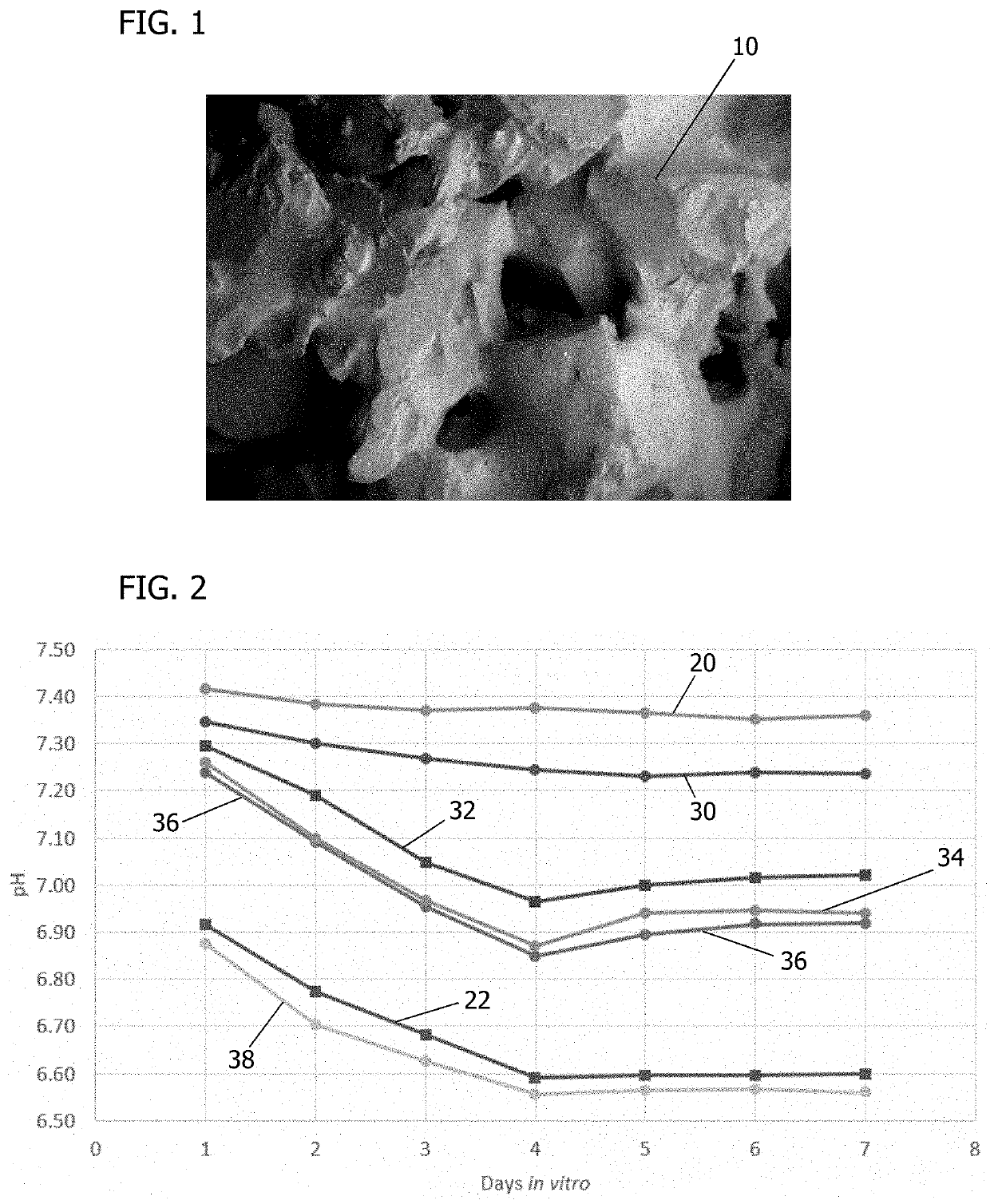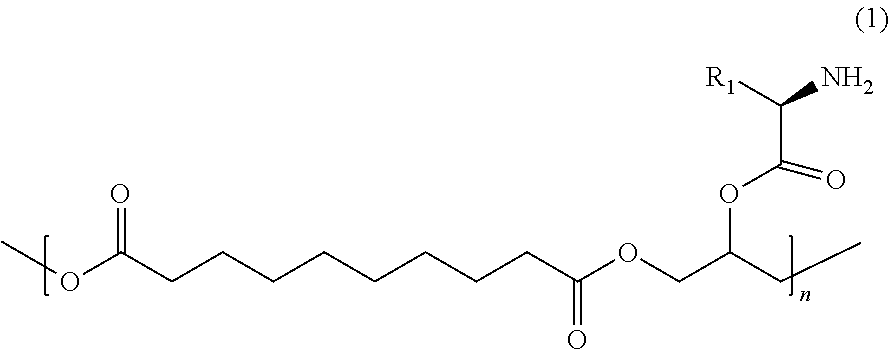pH-modulating biodegradable polymer and poly(glycerol sebacate)-augmented cell culture media
a biodegradable polymer and poly(glycerol sebacate) technology, applied in biochemistry apparatus and processes, culture processes, prosthesis, etc., can solve the problems of insufficiently or fully mimicking in vivo environment of materials used in these 3-d cell culture bioreactors, and the difficulty of culturing cells on pgs substrates, etc., to reduce the ph of the buffered aqueous solution
- Summary
- Abstract
- Description
- Claims
- Application Information
AI Technical Summary
Benefits of technology
Problems solved by technology
Method used
Image
Examples
example 1
[0086]Four separate pH-modulating PGS resins were produced by charging 5.0±0.1 g of His, Lys, Arg, or Tyr into 95±1 g of Regenerez® PGS resin (The Secant Group, LLC, Telford, Pa.) and about 20 mL of deionized water (diH2O) in a 500-mL reaction vessel. The materials in the vessel were heated to 120° C. under cool water reflux, then once all material was molten, the water was distilled off of the mixture under a nitrogen purge flowing at about 10 L / min. Once the water was removed, which took about 30 minutes, the reactor temperature was maintained at 120° C., and the pressure was reduced to 10 Torr. The remaining material was polymerized as such for about 4 hours then drained from the reactor. The resulting pH-modulating PGS resins, PGS-His (5%) resin, PGS-Lys (5%) resin, PGS-Arg (5%) resin, and PGS-Tyr (5%) resin, were then thermoset and / or characterized.
example 2
[0087]Additionally, the incorporation of His at 5%, Lys at 5% and 10%, Arg at 5%, and Tyr at 5% into PGS resins was attempted during PGS resin synthesis. Of the amino acids attempted, only lysine was sufficiently soluble under the PGS reaction conditions and favorably incorporated into the PGS resin in this manner. When the amino acid was added to the reaction prior to the nitrogen step, the amino acid amounts were calculated from the expected stoichiometric yield of PGS resin at the average acid value for oligomeric (glycerol sebacate) (OGS) and PGS resins.
[0088]The PGS-Lys (5%) resin was produced by charging 10.0±0.1 g of Lys into 59.4±0.1 g of glycerol and 130.6±0.1 g of sebacic acid and about 40 mL of deionized water (diH2O) in a 500-mL reaction vessel. The materials in the vessel were heated to about 120° C. under cool water reflux. Once all material was molten, the water was distilled off of the mixture under a nitrogen purge flowing at about 10 L / min. Once the water was remov...
example 3
[0090]Portions of each of the 5% pH-modulating PGS resins from Example 1 were thermoset as films of approximately a 1-mm thickness by pouring each molten pH-modulating PGS resin into a round aluminum dish, then heating to and maintaining the polymer at 130° C. and a reduced pressure of 10 Torr for 24 hours. The resultant films, PGS-His (5%) thermoset, PGS-Lys (5%) thermoset, PGS-Arg (5%) thermoset, and PGS-Tyr (5%) thermoset, were suitably cohesive and tack-free.
[0091]Surprisingly, the PGS-Lys (10%) resin from Example 2 was thermoset by heating to and maintaining the polymer at 120° C. for only 8 hours under a reduced pressure of 10 Torr, a significant reduction in time and a significant advantage for large-scale manufacture of the pH-modulating thermoset. The PGS-Lys (10%) thermoset was suitably cohesive and tack-free.
PUM
| Property | Measurement | Unit |
|---|---|---|
| temperature | aaaaa | aaaaa |
| temperature | aaaaa | aaaaa |
| temperature | aaaaa | aaaaa |
Abstract
Description
Claims
Application Information
 Login to View More
Login to View More - R&D
- Intellectual Property
- Life Sciences
- Materials
- Tech Scout
- Unparalleled Data Quality
- Higher Quality Content
- 60% Fewer Hallucinations
Browse by: Latest US Patents, China's latest patents, Technical Efficacy Thesaurus, Application Domain, Technology Topic, Popular Technical Reports.
© 2025 PatSnap. All rights reserved.Legal|Privacy policy|Modern Slavery Act Transparency Statement|Sitemap|About US| Contact US: help@patsnap.com


